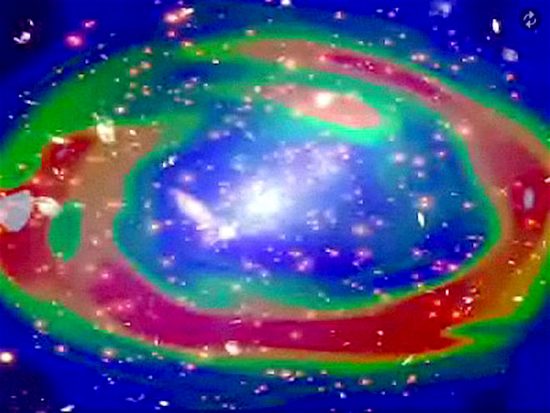Feb 13, 2017
Earth displays its celestial nature.
Intense lightning in thunderstorms can interact with electricity (cosmic rays) coming from space. When the right conditions in Earth’s atmosphere occur, lightning causes giant particle accelerators to form above the clouds.
Cosmic rays are high energy sub-atomic particles, mostly protons, that can knock electrons off air molecules. Since lightning flashes create powerful electric fields, those free electrons accelerate upward through the mesosphere in a narrow beam, connecting near-Earth space with the ground. Those electrons, along with the solar wind, are the principle source for the Van Allen Belts.
Most of the electric charge in lightning is contained in the “return stroke”. Negatively charged leaders descend from the clouds, seeking positive charges in another cloud or on the ground. Those negative charges form tubes of ionized air molecules that connect to positive charges, so protons ascend the ionized filaments. Return strokes can deliver as much energy as 100,000 volts at 100,000 amps, on average: about 10 billion watts in a few milliseconds.
Once there is sufficient charge build-up, several kinds of discharge events take place between the cloud tops and the mesosphere. Two of those events were discovered within the last 30 years: red sprites and blue jets.
Red sprites are massive, diffuse flashes above active thunderstorms, coinciding with normal lightning strokes. They can be single events, or multiple, with filaments above and below, often extending to altitudes close to 100 kilometers. Some of the largest sprites contain dozens of individual smaller sprites, covering horizontal distances of 50 kilometers, with a volume of 10,000 cubic kilometers.
Blue jets are distinct from sprites, since they propagate upward in narrow cones that disappear at an altitude of about 50 kilometers. They are also more powerful because the electric discharges are confined within a smaller spatial volume. Geophysicists are now realizing that sprites and jets are part of every moderate to large thunderstorm and are an essential component in Earth’s electric circuit.
Electric Universe theory states that what is observed on other planets, within galaxies, or in free space should be used as examples of what can occur on Earth, rather than the other way around. Earth is part of a cosmic “ecology” that maintains a coherent physical aspect regardless of scale. Since the Universe is composed of matter in the plasma state, that aspect ought to apply everywhere. Therefore, what takes place in thunderstorms on Earth is most likely a smaller version of large scale phenomena in stars and galaxies.
The European Space Agency launched the INTEGRAL satellite from the Baikanor Cosmodrome on October 17, 2002. It is the first space-based observatory that can study objects in gamma ray, X-ray, and visible light. One of INTEGRAL’s major observations was an extreme X-ray source from the center of the Ophiuchus galaxy cluster.
ESA astrophysicists suggested that shockwaves had “turned the galaxy into a giant particle accelerator”. The temperature of gases in the cluster core were measured at 100 million Kelvin, so it was thought that electrons accelerated by shockwaves traveling through the cluster generated the intense X-rays. The shockwaves were said to be from two galaxy clusters that “collided and merged.”
By referring to material with a temperature of 100 million Kelvin as “hot gas,” ESA scientists highlight their ignorance of plasma and its behavior. No atom can remain intact at such temperatures: electrons are stripped from the nuclei and powerful electric fields develop, characteristics of plasma, which is capable of conducting electricity and forming double layers.
Nobel laureate Hannes Alfvén maintained that double layers are a unique celestial object, and that intense X-ray and gamma ray sources could be due to double layers “shorting out” and exploding. Double layers can accelerate charged particles up to enormous energies in a variety of frequencies, forming “plasma beams”. If the charge density becomes excessive, they explode, drawing electricity from the entire circuit and discharging more energy than was contained in the double layer.
Double layers dissipate when they accelerate particles and emit radiation, so they must be powered by external sources. Birkeland currents are theorized to transmit electric power over many light-years through space, perhaps over thousands of light-years, so they are most likely the power source for the extreme X-ray generator in Ophiuchus.
Particle accelerators in thunderstorms and galaxy clusters are manifestations of Birkeland currents pouring electricity into double layers. Sprites and jets exhibit filamentary structure, as does terrestrial lightning. Streamers of plasma can be seen flowing through galaxy clusters. The plasma Universe reveals itself through electrical events both large and small.
Stephen Smith













